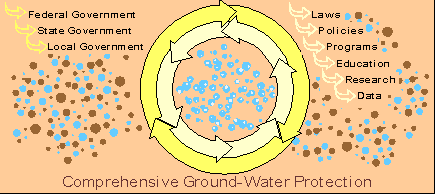
| Source Water Protection | ||

|
|
|||||||||
|
Protecting the Nation's Ground Water: EPA strategy for the 1990s.
July 1991. Final Report of the EPA Ground Water Task Force. EPA 21Z-1020. Office of the Administrator, U.S. Environmental Protection Agency. Paper, 84 pages. This report contains EPA policy and principles for implementing aggressive ground water protection strategies in the 1990s. It seeks to guide the agency's, states' and local governments' efforts to prevent ground water contamination through effective partnerships and consistent decisionmaking. To accomplish this goal, the report enfolds the following documents:
As a statement of agency policy and principles, this document does not affect legal rights or obligations.
Principles. EPA's overall goal is to prevent adverse effects to human health and the environment and protect the nation's ground water resources in accord with federal law. It will counter adverse effects (significant and reasonable risks) to the resource and the population in the near and long-term. Prevention is emphasized because ground water cleanup is costly and difficult. Safe drinking water is the primary goal, along with the protection of interconnected surface water resources and ecosystems. Remediation strategies will consider the use, value, and vulnerability of the resource as well as social and economic values to set realistic priorities based on actual and expected uses. In addition, strategies will link and coordinate federal, state, and local government efforts for the protection of all media — air, water, and land resources and practices. Federal-State Relationship. The state role in ground water protection is critical; therefore, efforts should be resource-based with an emphasis on prevention and sustainability. EPA reviews state programs to help states become fully capable of comprehensive ground water protection and defers to the states that have adequate programs." Adequate programs:
Implementation. EPA's approach to implementation uses an ongoing policy committee and various workgroups to support the Comprehensive State Ground Water Protection Program (CSGWPP). Regional offices review all activities to set goals, identify and deploy available resources, maintain the planning process, and conduct reviews. Policy and Standards. EPA policy on the use of standards determines specific decisions related to statutory responsibilities. In particular, EPA uses maximum contaminant levels (MCLs) as reference points for safe drinking water, and water quality standards when the ground water supply is closely connected to surface waterbodies. Best technologies and management practices are used for prevention, and remediation efforts attempt to reach a total lifetime cancer risk of one in 10,000 to one in 100,000, and to maintain exposures to noncarcinogens to below reference doses. Data Management. Data resources are needed in the 1990s because no regional ground water data management resources exist as they do for air and surface water. Ground water data consistency, quality, and automation should be supported and linked to other systems, such as geographic information systems (GIS). A directory of systems pointing to other data sources and a level of data useful to each region should be developed, and more area-specific mapping should be accomplished. The Data Management Subcommittee's Report (October 1990) provides an overview of data management in EPA to showcase the resources of various offices and indicates that data supports ground water decisions for permitting and compliance, risk assessments, remedial actions, oversight, wellhead and aquifer protection, and pesticide impacts. Analysis of baseline, trend, automation, research, and quality data is urgently needed. Changes underway include modernizing STORET and maintaining GIS. We should also devote more time to pilot and demonstration projects. Office of Research and Development (ORD) Ground Water Research Plan. ORD efforts focus on serving EPA programs that need an increasingly sophisticated knowledge base and greater technical assistance. Prevention and remediation are the major research themes or objectives that ORD pursues for EPA clients using basic and field-tested techniques and coordinating its work with other research agencies. Research programs need to stay in the forefront scientifically, meet users needs, and be coordinated with external programs. Funding is always a problem, but the potential results of not continuing ground water research are costlier. They include the loss of early detection and limited protection as a result of untested monitoring approaches; the uneven prediction of contaminant transport with subsequent possible risk; poor source control planning; inefficient, ineffective remedial actions at hazardous waste sites.
The full copy of this publication can be obtained from the National Technical Information Service (NTIS) at 1-800-553-6847, order number PB92-224765.
|
|
|
||
|
|